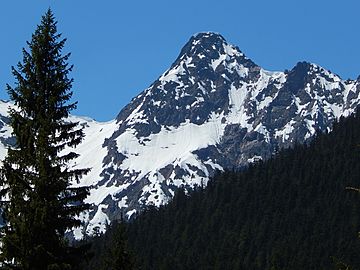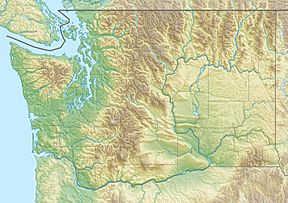Kitling Peak facts for kids
Quick facts for kids Kitling Peak |
|
|---|---|

Kitling Peak seen from the North Cascades Highway
|
|
| Highest point | |
| Elevation | 8,003 ft (2,439 m) |
| Prominence | 523 ft (160 m) |
| Isolation | 0.54 mi (0.87 km) |
| Geography | |
| Location | Skagit County, Washington, US |
| Parent range | North Cascades Cascade Range |
| Topo map | USGS Mount Arriva |
| Climbing | |
| First ascent | August 24, 1968, John Roper, Chris Roper |
| Easiest route | Scrambling |
Kitling Peak is a tall mountain, about 8,003 feet (2,439 meters) high, located in the Cascade Range in the U.S. state of Washington. It's found near Easy Pass, right on the edge of the Stephen Mather Wilderness and North Cascades National Park.
Its name, "Kitling," comes from an old language called Chinook Jargon. In that language, "ketling" means "kettle" (like a bowl-shaped valley). The mountain is named after Kitling Lake, which is about a mile north of it. The United States Board on Geographic Names officially gave it this name in 1969.
Kitling Peak is at the eastern end of a ridge called Ragged Ridge. Other mountains on this ridge include Mesahchie Peak, Kimtah Peak, Katsuk Peak, and Graybeard Peak. The closest mountain that's even taller is Mesahchie Peak, less than a mile to the south. A glacier called Mesahchie Glacier sits on Kitling's northwest side. It's where Panther Creek starts. Rain and melting snow from the east side of the mountain flow into Ross Lake through Granite Creek. Water from the west side of the peak flows into Diablo Lake through Panther Creek and Fisher Creek.
Contents
Weather at Kitling Peak
Kitling Peak is in a "marine west coast" climate zone, which means it's near the ocean and gets a lot of moisture. Most weather systems start over the Pacific Ocean and move northeast towards the Cascade Range.
How Mountains Affect Weather
When these weather systems hit the North Cascades, the mountains force the air to rise. This process is called Orographic lift. As the air goes higher, it cools down and drops its moisture as rain or snow. This is why the west side of the North Cascades gets a lot of precipitation, especially heavy snowfall in winter.
Seasonal Weather Patterns
During the winter, the weather is usually cloudy. However, in the summer, high-pressure systems over the Pacific Ocean become stronger, often leading to clear skies with little to no clouds. Because of the ocean's influence, the snow tends to be wet and heavy. This type of snow can increase the risk of avalanches, which are large slides of snow down a mountainside.
The Story of the Mountains
The North Cascades are known for their very rugged landscape. They have sharp, craggy peaks, tall spires, long ridges, and deep valleys carved by glaciers. The amazing shapes of these mountains and the big changes in elevation were created by geological events that happened millions of years ago. These events also led to the different climates you see across the Cascade Range.
How the Cascades Were Formed
The formation of the Cascade Mountains began millions of years ago, during a time called the late Eocene Epoch. At that time, the North American Plate (a huge piece of Earth's crust) was slowly moving over the Pacific Plate. This movement caused many volcanic eruptions and other fiery rock activity.
Also, small pieces of the Earth's crust, called terranes, came together to form the North Cascades about 50 million years ago.
Ice and Earthquakes
During the Pleistocene period, which started over two million years ago, glaciers repeatedly advanced and retreated. As these huge ice sheets moved, they scraped and shaped the land, leaving behind piles of rock debris. The river valleys in the area have a "U" shape, which is a clear sign that glaciers once moved through them.
The combination of the land being pushed upwards (called uplift) and cracks forming in the Earth's crust (called faulting), along with the powerful work of glaciers, are the main processes that created the tall peaks and deep valleys we see in the North Cascades today.


